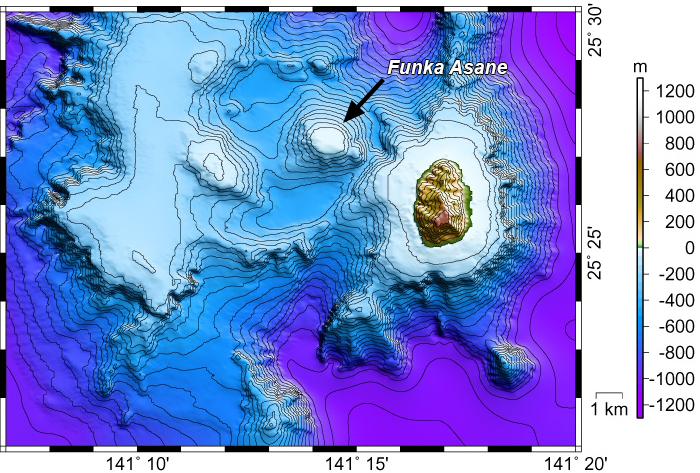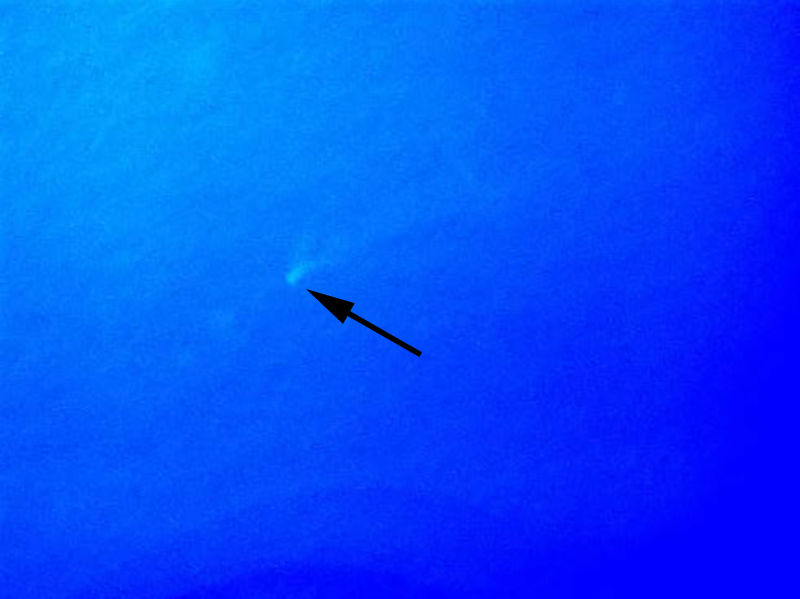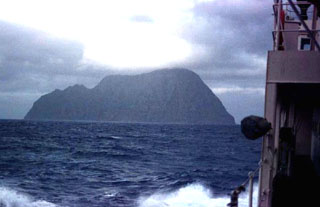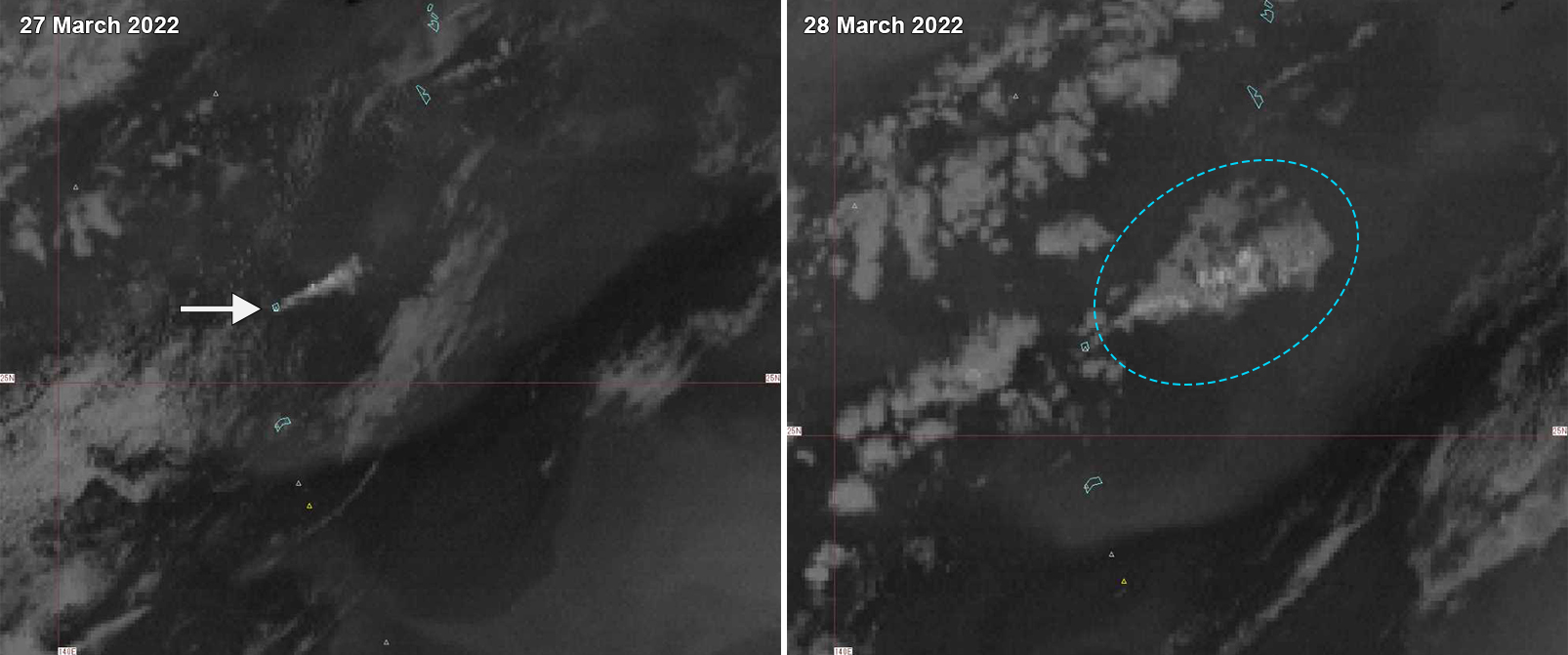Report on Kita-Ioto (Japan) — June 2022
Bulletin of the Global Volcanism Network, vol. 47, no. 6 (June 2022)
Managing Editor: Edward Venzke.
Edited by Kadie L. Bennis.
Kita-Ioto (Japan) Submarine eruption in late March-April 2022
Please cite this report as:
Global Volcanism Program, 2022. Report on Kita-Ioto (Japan) (Bennis, K.L., and Venzke, E., eds.). Bulletin of the Global Volcanism Network, 47:6. Smithsonian Institution. https://doi.org/10.5479/si.GVP.BGVN202206-284110
Kita-Ioto
Japan
25.424°N, 141.284°E; summit elev. 792 m
All times are local (unless otherwise noted)
Kita-Ioto (also known as “Kita-Iwo Jima”) is located about 1,100 km S of Tokyo, Japan. It is a highly eroded stratovolcano with a steep-sided cone that rises about 800 m above the ocean surface. Eruptions from the Funka Asane submarine vent, 4-5 km NW of the main cone (figure 1), have been recorded since 1780, characterized by submarine eruptions during 1780, 1880, and 1930-1945, discolored seawater, and some degassing. This report summarizes previous events of discolored water and degassing, and includes a more recent events consisting of an eruption plume and discolored water during March-April 2022. Information for this report comes primarily from the Japan Coast Guard (JCG), the Japan Meteorological Agency (JMA), the Tokyo Volcanic Ash Advisory Center (VAAC), and satellite data.
 |
Figure 1. Bathymetric and topographic map showing the island of Kita-Ioto on the right and the submarine Funka Asane cone to the NW. Courtesy of JCG. |
Summary of activity. Visual observations of discolored water, and later, occasional degassing bubbles have been made at Funka Asane since May 1953 (table 1). Discolored water typically originates from a point source and appears pale green, yellow-green, blue-white, or milky white; on 5 November 2003, for example, discolored bluish-white water was visible from a single point (figure 2). Some of the discolored areas extended in different directions for 10-200 m, the latter of which occurred on 26 January 2000 and 10 March 2003. On 25 January 2000 three points of bluish-white discolored water appeared at 1410-1425. Pumice-like material was observed floating to the NE of the discolored water with a width of over 500 m and a length of 1.5 km. By the 26th during 0925-0930, the three points decreased to two points and the thin, milky white discolored water extended 200 m NNW, and no floating material was observed. On 16 March 2006 bubbles were first observed during 0942-0949. This type of event occurred intermittently through 9 March 2012. During 1330-1334 on 5 August 2021 light blue-white discolored water was reported by JCG to the S of Kita-Ioto. JCG also made observation flights over the area where they noted no activity. These flights were made on 14 June 2005, 26 February 2009, 30 June 2013, 17 August 2015, 24 December 2016, 24 March 2017, 11 December 2017, 18 July 2018, 29 January 2019, 19 November 2019, 8 June 2021, 9 July 2021, 11 November 2021, 27 December 2021, 15 March 2022, and 29 March 2022.
Table 1. Summary of observations made at Funka Asane between May 1953 and August 2021 by Japanese authorities. The Japan Coast Guard visited the site intermittently, noting occasional water discoloration, degassing bubbles, and one observation of floating material. Data from JMA (Japan Meteorological Agency) and JCG (Japan Coast Guard).
| Date | Eruption event | Description | Source |
| May 1953 | Seawater discoloration | Whitening and sulfur smell. | JMA (2005), List of active volcanoes in Japan (3rd edition) |
| Aug 1968 | Seawater discoloration | -- | JMA (2005), List of active volcanoes in Japan (3rd edition) |
| Jun 1982 | Seawater discoloration | -- | JMA (2005), List of active volcanoes in Japan (3rd edition) |
| Jul 1983 | Seawater discoloration | -- | JMA (2005), List of active volcanoes in Japan (3rd edition) |
| Aug 1987 | Seawater discoloration | -- | JMA (2005), List of active volcanoes in Japan (3rd edition) |
| Jul 1989 | Seawater discoloration | -- | JMA (2005), List of active volcanoes in Japan (3rd edition) |
| 10 Mar 1997 | Seawater discoloration | Small area of pale green discolored water. | JCG, Oceanographic Information Department (2006), Marine volcano database |
| 21 May 1998 | Seawater discoloration | Yellow discolored water 10 m long, and green discolored water. | JCG, Oceanographic Information Department (2006), Marine volcano database |
| 27 Oct 1998 | Seawater discoloration | Green discolored water, and two spots of blue-white discolored water about 500 m SE of Asane. | JCG, Hydrographic Department (1999), Recent activities of submarine volcanoes |
| 07 Sep 1999 | Seawater discoloration | Pale yellow-green discolored water with a diameter of about 50 m at two locations near 25°27.3’N and 141°13.4’E. | JCG, Oceanographic Information Department (2006), Marine volcano database |
| 16 Sep 1999 | Seawater discoloration | Discolored water about 40 m in diameter. | JCG, Oceanographic Information Department (2006), Marine volcano database |
| 25 Jan 2000 | Seawater discoloration | Three spots of blue-white discolored water during 1410-1425. Area of “pumice-like material” over 500 m wide flowing 1.5 km NE from the discolored water. | JCG, Oceanographic Information Department (2006), Marine volcano database |
| 26 Jan 2000 | Seawater discoloration | The three spots of discolored water had decreased to two points when seen at 0925-0930; thin milky white discolored water with a length of 200 m extending NNW and no floating material. | JCG, Oceanographic Information Department (2006), Marine volcano database |
| 30 Oct 2000 | Seawater discoloration | Small area of blue-white discolored water. | JCG, Oceanographic Information Department (2006), Marine volcano database |
| 29 Oct 2001 | Seawater discoloration | A fan-shaped area of blue-white discolored water was about 100 m in diameter. Yellow-green discolored water with a diameter of about 500 m was located about 2 km W of the volcano. | JCG, Oceanographic Information Department (2006), Marine volcano database |
| 28 Feb 2002 | Seawater discoloration | Two circular blue-white discolored water spots with a diameter of about 200 m. | JCG, Oceanographic Information Department (2006), Marine volcano database |
| 10 Mar 2003 | Seawater discoloration | A blue-green shoal was visible, but no volcanic activity was observed. Light yellow-green discolored water with a length of about 200 m originating from two locations about 500 m E of shallow water and extending NE. | JCG, Oceanographic Information Department (2006), Marine volcano database |
| 04 Nov 2003 | Seawater discoloration | Intermittent blue-white discolored water with a diameter of about 50-100 m. | JCG, Oceanographic Information Department (2006), Marine volcano database |
| 16 Mar 2006 | Bubbling | Some degassing bubbles observed during 0942-0949. | JCG |
| 22 Jan 2007 | Bubbling | Some degassing bubbles observed during 1347-1350. | JCG |
| 20 Mar 2007 | Discolored water and bubbling | Some degassing bubbles observed during 1234-1243 and yellow-green discolored water was about 50 x 100 m extending NW. | JCG |
| 11 Jul 2007 | Discolored water and bubbling | Some degassing bubbles and discolored milky water with a diameter of about 10 m seen during 1148-1152. | JCG |
| 17 Oct 2007 | Bubbling | Some bubbling observed during 1330-1345. | JCG |
| 12 Feb 2008 | Bubbling | Some bubbling observed at 1240. | JCG |
| 20 Jul 2008 | Discolored water and bubbling | Elliptical area of blue-white water about 50 x 150 m. Some degassing bubbles were also observed during 1320-1327. | JCG |
| 24 Dec 2009 | Discolored water and bubbling | Discolored blue-white water and degassing bubbles observed during 1155-1202. | JCG |
| 29 Sep 2010 | Discolored water | Discolored blue water had a diameter of 20 m during 1354-1412. | JCG |
| 8 Feb 2011 | Discolored water | Discolored blue water had a diameter of 20 m during 1244-1316. | JCG |
| 16 Nov 2011 | Discolored water and bubbling | Light blue discolored water had a diameter of 20-30 m accompanied by bubbling during 1153-1203 and 1333-1342. | JCG |
| 9 Mar 2012 | Discolored water and bubbling | Discolored blue and light brown water had a diameter of 50 m accompanied by bubbling during 1247-1253. | JCG |
| 21 Aug 2012 | Discolored water | Some light green and a small amount of pale blue discolored water extended E during 1415-1419 | JCG |
| 26 Mar 2013 | Discolored water | Milky white water observed N of the volcano and blue-white discoloration to the SE. | JCG |
| 29 Mar 2016 | Discolored water | Pale blue-white discolored water at three points with a diameter of 30-100 m during 1350-1430. | JCG |
| 28 Jun 2017 | Discolored water | Pale blue-white discolored water 50 m in diameter during 1431-1438. | JCG |
| 05 Aug 2021 | Discolored water | Light blue-white discolored water S of the volcano during 1330-1334. | JCG |
 |
Figure 2. Photo of blue-white discolored water originating from a single point at the Funka Asane submarine vent of Kita-Ioto on 5 November 2003 (black arrow). Courtesy of JCG. |
Activity during March-April 2022. A submarine eruption at Funka Asane was reported by JMA based on satellite images at 1800 on 27 March 2022. An eruption plume rose to 5.5 km altitude at 2100 and may have contained some ash (figure 3). By 2330 and through at least 0300 on 28 March, the plume had risen to 7 km altitude, according to HIMAWARI satellite images (figure 3). The altitude of the plume had dropped to 3.6 km at 0820 on 28 March, and by 1420 it was no longer visible. Aerial observations by JCG on 29 March did not detect discolored water or floating objects surrounding Funka Asane.
A small amount of brown floating material was observed during 1329-1400 on 18 April, originating from the N crater, about 5 km SE from Funka Asane, according to observations made by JCG. Some light brown and yellow-green discolored water were seen off the N coast to the W coast of the volcano (figure 4).
Geological Summary. No historical eruptions have occurred from the deeply eroded Kita-Ioto stratovolcano, which forms a steep-sided basaltic cone rising about 800 m above the sea. However, eruptions have been recorded since the 18th century from Funka Asane, a submarine vent 4-5 km NW of the island. Kita-Ioto is the northernmost of the Kazan Retto (Volcano Islands), located in the middle of the Izu-Marianas arc.
Information Contacts: Japan Coast Guard (JCG) Volcano Database, Hydrographic and Oceanographic Department, 3-1-1, Kasumigaseki, Chiyoda-ku, Tokyo 100-8932, Japan (URL: https://www1.kaiho.mlit.go.jp/GIJUTSUKOKUSAI/kaiikiDB/kaiyo18-e1.htm); Japan Meteorological Agency (JMA), 1-3-4 Otemachi, Chiyoda-ku, Tokyo 100-8122, Japan (URL: http://www.jma.go.jp/jma/indexe.html); Tokyo Volcanic Ash Advisory Center (VAAC), 1-3-4 Otemachi, Chiyoda-ku, Tokyo 100-8122, Japan (URL: http://ds.data.jma.go.jp/svd/vaac/data/).



